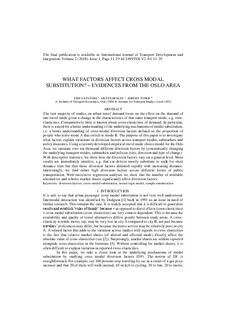| dc.contributor.author | Flugel, Stefan Markus | |
| dc.contributor.author | Fearnley, Nils | |
| dc.contributor.author | Toner, Jeremy P | |
| dc.coverage.spatial | Norway | nb_NO |
| dc.date.accessioned | 2019-06-27T07:45:33Z | |
| dc.date.available | 2019-06-27T07:45:33Z | |
| dc.date.created | 2017-11-29T12:00:16Z | |
| dc.date.issued | 2017-11-27 | |
| dc.identifier.citation | International Journal on Transport Development and Integration. 2018, 2 (1), 11-29. | nb_NO |
| dc.identifier.issn | 2058-8305 | |
| dc.identifier.uri | http://hdl.handle.net/11250/2602458 | |
| dc.description.abstract | The vast majority of studies on urban travel demand focus on the effect on the demand of one travel mode given a change in the characteristics of that same transport mode, for example, own-elasticities. comparatively little is known about cross-elasticities of demand. In particular, there is a need for a better understanding of the underlying mechanisms of modal substitution, that is a better understanding of cross-modal diversion factors (Dfs) defined as the proportion of people who leave mode a and switch to mode b. The purpose of this article is to investigate what factors explain variations in Dfs across transport modes, submarkets and policy measures. using a recently developed empirical travel mode choice model for the Oslo area, we simulate over 10,000 different Dfs by systematically changing the underlying transport modes, submarkets and policies (size, direction and type of change). With descriptive statistics, we show how the Dfs vary on a general level. most results are immediately intuitive, for example that car drivers mostly substitute to walk for short-distance trips but that those Dfs diminish rapidly with increasing distance. Interestingly, we find rather high Dfs across different forms of public transportation. With successive regression analyses we show that the number of available alternatives and relative market shares significantly affect Dfs. | nb_NO |
| dc.language.iso | eng | nb_NO |
| dc.publisher | WIT Press | nb_NO |
| dc.rights | Attribution-NonCommercial-NoDerivatives 4.0 Internasjonal | * |
| dc.rights.uri | http://creativecommons.org/licenses/by-nc-nd/4.0/deed.no | * |
| dc.title | What Factors Affect Cross-Modal Substitution - Evidences from the Oslo Area | nb_NO |
| dc.title.alternative | What Factors Affect Cross-Modal Substitution - Evidences from the Oslo Area | nb_NO |
| dc.type | Journal article | nb_NO |
| dc.type | Peer reviewed | nb_NO |
| dc.rights.holder | © 2018 WIT Press, www.witpress.com | nb_NO |
| dc.description.version | acceptedVersion | nb_NO |
| cristin.unitcode | 7482,3,2,0 | |
| cristin.unitcode | 7482,1,5,0 | |
| cristin.unitname | Transportmodeller | |
| cristin.unitname | Marked og styring | |
| cristin.ispublished | true | |
| cristin.fulltext | postprint | |
| cristin.qualitycode | 1 | |
| dc.identifier.doi | 10.2495/TDI-V2-N1-11-29 | |
| dc.identifier.cristin | 1520148 | |
| dc.source.journal | International Journal on Transport Development and Integration | nb_NO |
| dc.source.volume | 2 | nb_NO |
| dc.source.issue | 1 | nb_NO |
| dc.source.pagenumber | 11-29 | nb_NO |
| dc.relation.project | Norges forskningsråd: 246836 | nb_NO |

